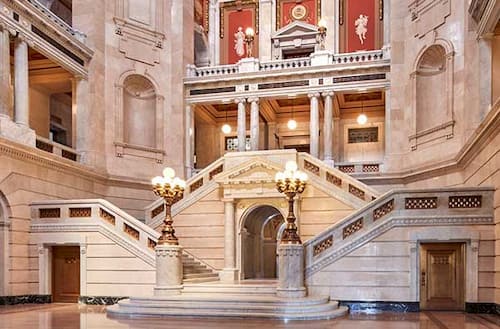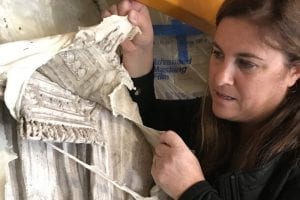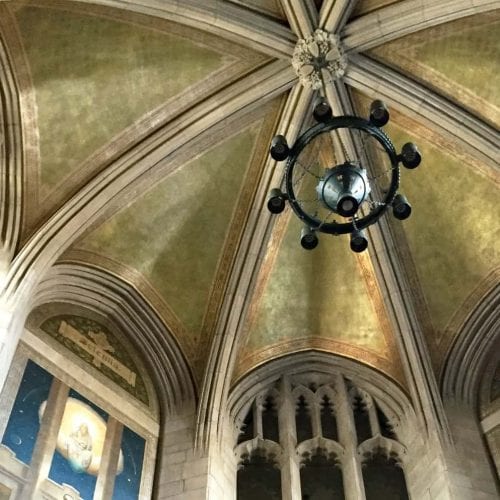Historic Stone Restoration & Repair
Breathe New Life Into Your Historic Stonework.
 In many historic buildings, homes, and other structures, it is not uncommon to find beautiful stonework and masonry—both as decorative and structural elements. Stone and marble statues, memorials, shrines, walls, flooring, columns, and other architectural features can be found throughout the country and across countless architectural styles and periods.
In many historic buildings, homes, and other structures, it is not uncommon to find beautiful stonework and masonry—both as decorative and structural elements. Stone and marble statues, memorials, shrines, walls, flooring, columns, and other architectural features can be found throughout the country and across countless architectural styles and periods.
Unfortunately, as with other structural and decorative elements like plaster and wood, stone and marble can become damaged with the passage of time. Surfaces accrue soot and grime, sheen loss, staining from structural supports embedded in the stone, mortar and joints can fail, and elements can crack, chip, or become otherwise damaged.
With decades of experience in historic restoration, preservation, and conservation, Canning’s artisans and tradesmen are highly skilled and capable in all aspects of stone restoration and repair, from relatively simple cleaning to more complex repair work achieved using a variety of methods—carving, casting, filling, and more.
Testimonials
“Canning understands materials and specifications, especially traditional materials and techniques, and understands and appreciates the benefits of a truly collaborative effort in design excellence. [WV Capitol Dome]”
— ELIZABETH A. MOSS, LEED AP, ARCHITECTURAL CONSERVATOR, SWANKE HAYDEN CONNELL ARCHITECTS, NEW YORK CITY
“The project included extensive repairs to the Library’s crowning architectural feature, a vaulted Guastavino tile ceiling. Canning & Co. provided exceptional craftsmanship, meticulous project management, and the highest level of respect and care for the Museum’s special environment. The results were spectacular. We applaud Canning & Co for a truly inspirational level of commitment to excellence in historic preservation.”
—DONNA D. CURTIN, PhD, EXECUTIVE DIRECTOR, PILGRIM HALL MUSEUM, PLYMOUTH, MASSACHUSETTS
“Canning’s craft and artistry take aspects of a design to absolute levels of refinement that bring new works to unexpected levels of delight. Visitors are amazed that such craft is still alive and well in our expedient world.”
— JOHN I. MEYER, AIA, MEYER & MEYER ARCHITECTURE AND INTERIORS, BOSTON, MASSACHUSETTS
“I have had the pleasure of working with artisans in many countries overseas. Canning truly ranks among the best in the world!”
— VIVEN P. WOOFTER, IIDA, CULTURAL HERITAGE OFFICER, OVERSEAS BUILDINGS OPERATIONS, US DEPARTMENT OF STATE
Our Process


While each project offers its own unique challenges and constraints, most stone restoration and repair projects follow a similar process and approach.
Before conducting any work, our goal is to first understand the history of the structure we are working on, including the role played by the various stone or marble elements. This understanding will typically be achieved by a mixture of investigation and archival research. At the same time, we must understand the full scope of the project being pursued—including the budget, expectations, and aspirations of the owner and other key stakeholders—in order to appropriately plan and coordinate between other trades as necessary.
Once the project is fully understood, we must evaluate the current structure in order to identify the type of stone used, stabilize the structure as necessary, document areas of damage, test various cleaning solutions, and create an initial treatment proposal.
If treatment is to include cleaning of the stone or marble, we will identify the least aggressive and mildest solution that can be used to achieve the desired results—without changing the original color or appearance of the stone or otherwise damaging the structure.
This can be achieved through a number of processes. On the simpler end might be the application of cleaning solution by hand using natural sponges. Other processes may include a variety of poultice methods designed to draw impurities out of the stone, such as by applying a latex (or other) compound to the surface, which encapsulates the debris and then pulls it away from the surface once dried—particularly effective on extremely detailed pieces.
If treatment is to include repair to the stone or marble, the specific course of action will of course depend on the damage that must be corrected. Some potential repairs may include providing Dutchman at damaged, sugaring, or deteriorated areas, the removal and resetting of existing stones, repointing, or sourcing matching stone or marble. If sourcing the exact same stone or material as used in the original would be prohibitively expensive, it may be possible for our expert craftsmen to replicate the stone in another material such as scagolio or faux marbres.
Cost Factors
The costs associated with stone restoration and repair will depend upon a number of factors specific to each individual project. Some of the most important considerations include:
- The type of stone and other materials being worked with
- The size, complexity, and scope of the project
- Accessibility (example, whether scaffolding will be required to conduct the work)
- Whether the underlying structure must be repaired, stabilized, or restored
- For projects located in public spaces, whether the work will take place during business or off hours
For this reason, it is difficult for us to state what typical costs might be for the “average” project. The surest way to get an accurate picture of what the costs may entail would be to contact us directly.
Our Specialties
In addition to stone restoration and repair, we specialize in a number of other complementary services, including:
SELECTED PROJECTS
We carefully conserved and restored all aspects of the Luzerne County Courthouse's historic fabric: marble, metal, plaster, paint, and mural artwork.
The St. Mary’s Chapel restoration involved conservation cleaning without damaging the surface or altering the color of the historic cast stone.
At Gasson Hall, Boston College, we provided the historic finishes investigation and analysis needed to restore the interior to its original design scheme.
We were able to uncovered original colors, patterns, and finishes to conserve 24 murals while restoring Stations of the Cross and the scagliola columns.
Canning Liturgical Arts performed varying scopes of conservation for the Basilica.
Our exposures revealed complex design throughout the Shrine, so we needed to reinstate the original design scheme and match the original color palette.






